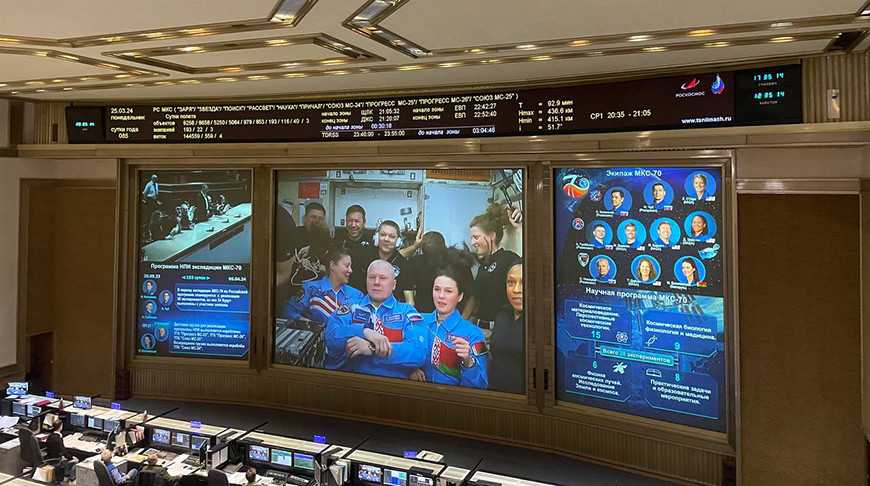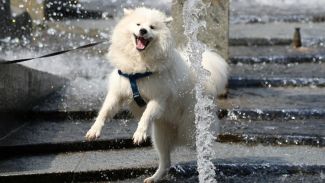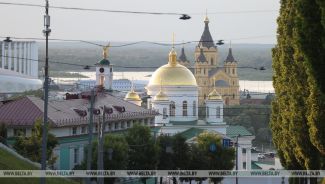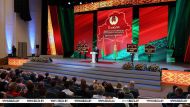
A photo of the Roscosmos video feed
Marina Vasilevskaya, the first cosmonaut of sovereign Belarus, has started working at the International Space Station after leaving behind one of the most complicated stages of the flight: the difficulty and risk of the journey from takeoff to the crew transfer vehicle’s docking at the ISS is probably on par with the landing of a crew return vehicle. Members of the 21st visiting expedition to the ISS had to spend over two days in outer space. After the spacecraft reached the intended orbit it made 34 orbital loops around Earth before it docked at the ISS. A BelTA reporter watched the arrival of the manned crew transfer vehicle Soyuz MS-25 at the ISS from the mission control center of the Russian space agency Roscosmos in Korolyov, Moscow Oblast.
The first two days in outer space
The crew consists of representatives of three countries: the vehicle commander, Hero of Russia, native of Belarus Oleg Novitsky, the Belarusian woman cosmonaut Marina Vasilevskaya, and the NASA astronaut Tracy Dyson. The start of their flight was exciting: on 21 March the launch was canceled by automatics within seconds of ignition of the launch vehicle Soyuz-2.1a’s engines. According to Roscosmos Director General Yury Borisov, the automatics kicked in in response to low voltage of a chemical power source in the rocket. No manned launches have ever been canceled in the history of Russian cosmonautics when the crew was already in the spacecraft. But one flight was cancelled in the USSR times: the launch of the Soyuz-4 spacecraft in 1969. The cosmonaut Vladimir Shatalov was on board the Soyuz-4 spacecraft and preparing for the flight.

Since the Soyuz MS-25 launch had to be rescheduled to the reserve date of 23 March, ballistic conditions no longer allowed docking according to the original ultra-short two-loop scheme, which takes 3.5 hours. A traditional two-day flight scheme had to be used: rockets used only this scheme since 1986 when the Mir station was launched and right up to 2013. After that Russian cosmonautics started experimenting with other schemes for approaching the ISS – day-long flights, six-hour flights, and so on but the lengthy two-day scheme was still in use till 2020.

According to experts, the traditional flight to the ISS may be lengthy but it is reliable: it is possible to make course corrections at every stage of the journey if something goes wrong. However, it is quite a difficult test for cosmonauts: Soyuz ships have a lot of advantages and one significant disadvantage - they are cramped. Each of the three crew members has only 1.2m3 of free space taking into account the habitation module. Besides, the ship keeps spinning all the time, testing the vestibular apparatus of those on board. This scheme also has some advantages: astronauts need at least 24 hours to adapt to weightlessness. By spending so much time in flight Marina Vasilevskaya did not need adaptation time at the ISS.
According to the member of the backup crew Anastasia Lenkova, Belarus’ representatives were prepared for the fact that the journey to the ISS would not be easy. “We knew perfectly well that there are reserve days and we realized that if the two-loop scheme is not an option, then we will use the two-day scheme. Of course, no one expected it to turn out this way, and there was a little bit of worry [due to the canceled launch]. But we had been preparing, including training for the two-day scheme,” she said.

During the first two loops around Earth the crew members have to check the tightness of the compartments and readiness of the ship’s systems. They also need to verify the opening of solar panels. After two loops the cosmonauts are allowed to move to the household compartment and remove spacesuits.
Lock-on docking
For the first two days the spacecraft kept climbing from a lower trajectory to the ISS orbit. The docking process itself includes several stages. At about 15:47 Minsk time on 25 March Soyuz MS-25 began autonomous approach to the ISS. After 49 minutes the Kurs system kicked in. It is a radio equipment module designed to provide mutual measurements of motion parameters for searching, approaching and docking spacecraft with the orbital station. At about 17:47 Soyuz MS-25 began circling the ISS, then it hovered and docked. At 18:03 Soyuz MS-25 touched the station. Then the spacecraft locked on the node module Prichal of the Russian segment of the ISS.

“The docking was nominal, in automatic mode. The crew kept an eye on the process, but the automatic machine docked the spacecraft to the station very smoothly, according to the program. So, everything went smoothly,” Roscosmos Executive Director for Manned Space Programs Sergei Krikalev told reporters.
After docking the cosmonauts began preparing for transition to the ISS. This process also takes almost three hours: it is necessary to equalize pressure on the station and the transport vehicle, check the tightness of the docking, carry out a number of other important procedures, and only after that the transfer hatches may be opened.
Handshakes, hugs and the first video conference call to Earth
The Belarusian-Russian-American crew had been literally tired of waiting for the arrival of the Belarusian-Russian crew at the ISS. The crew of the 70th long expedition includes the Roscosmos cosmonauts Oleg Kononenko, Nikolai Chub, and Alexander Grebenkin and the NASA astronauts Loral O'Hara, Matthew Dominick, Michael Barratt, and Jeanette Epps. The “long-term residents” of the ISS warmly greeted the new arrivals with traditional handshakes and hugs.


The first video communication session of the new ISS residents Oleg Novitsky, Marina Vasilevskaya, and Tracy Dyson with Earth took place almost immediately after that. “I am happy that Belarus has successfully and safely reached the ISS. We spent two days in transit but it didn’t affect the mood. We are very happy it turned out like this. I liked everything a lot. Particularly the twist maneuver. Indeed, we have reached the stars through tribulations,” Marina Vasilevskaya said.
“We have arrived. We are happy. We are feeling excellent. We love you very much. We hug you! Thank you for supporting us. It is a great pleasure and gives us a lot of strength,” Marina Vasilevskaya shared her emotions with people in the mission control center.


Deputy Head of the Aerospace Activities Department of the National Academy of Sciences Ivan Bucha welcomed the arrival of Belarus’ first cosmonaut Marina Vasilevskaya at the International Space Station quite emotionally.
“Marina, the beautiful Belarusian flag and the emblem are on your chest. We are proud and happy! We’ve done it!” Ivan Bucha exclaimed in Roscosmos’ mission control center during the first communication session with the ISS after the manned crew transfer vehicle Soyuz MS-25 docked at the station.
Ivan Bucha warmly greeted the newest additions to the ISS crew, including NASA representatives. He wished them comfortable and useful stay at the station. “You have a tightly knit and beautiful collective,” he stated.
“I wish you all the best!” Ivan Bucha wished the cosmonauts.
Their friends and relatives could also talk to the cosmonauts.
The Belarusian member of the backup crew Anastasia Lenkova and Oleg Novitsky’s friends, People’s Artists of Russia Edgard Zapashny and Askold Zapashny also came to the mission control center in order to watch the docking process and root for the cosmonauts. “Of course, I am worried about Marina. We have been training together for eight months. And I am happy for her”, Anastasia Lenkova said.
And Edgard Zapashny congratulated Belarus on the historic event: the flight of the first cosmonaut Marina Vasilevskaya. “Many thanks to the presidents of Belarus and Russia for accomplishing such a great historical deed. It’s great,” he said. “I congratulate everyone on the fact that it happened and I also congratulate all of Belarus. Because it is a great event in the life of the state.”
"Marina Vasilevskaya will not just make outer space more beautiful because she is a beautiful girl, but she also has to do a lot of useful things that will benefit our entire planet,” Edgard Zapashny expressed confidence.
Full program
Marina Vasilevskaya raised the total number of countries, which citizens have been to the International Space Station, to 22. The expedition’s duration has been extended to 14 days because of the rescheduled launch and changes in the docking approach. It allows keeping the research part of the first Belarusian cosmonaut’s flight intact.

The research program of the Belarusian cosmonaut has been developed by the National Academy of Sciences of Belarus in association with Roscosmos and the Russian Academy of Sciences. It includes seven experiments: five for the sake of scientific research and two for education purposes. The scientific studies will focus on biology, physiology, autonomous operation of space stations, the remote sensing of Earth using photo and video spectrum equipment of Belarusian make already on board the International Space Station. The lactoferrin and probiotics made by scientific organizations of the National Academy of Sciences of Belarus will be examined as well in order to evaluate the possibility of using them later to create food for cosmonauts.

Marina Vasilevskaya and Oleg Novitsky are expected to get back to Earth on 6 April on board the Soyuz MS-24 spacecraft, which delivered the previous crew to the ISS on 15 September 2023. They will be accompanied by NASA’s Loral O’Hara who arrived at the ISS on board Soyuz MS-24.















